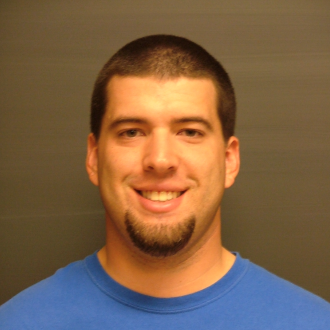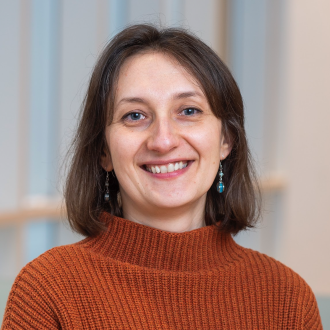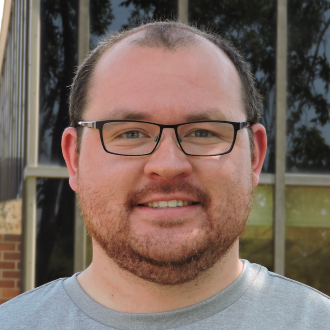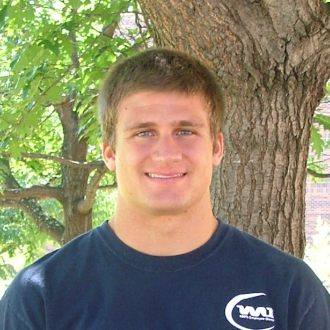Where do our graduates go after the Physics MS?
Annually, the Physics and Astronomy Department graduates 1-3 students typically each year in our Masters program.
Some students go on to academic research, but many do not and they take a wide variety of career paths. Graduates in physics and astronomy are amongst the most highly sought after across the modern STEM economy because of the skills they have acquired and developed in their degrees. If you want to learn more about what you can do with a degree in physics or astronomy, read the graduate highlights below.

Aaron Stokke, MS 2018
Aaron graduated in 2018 from the Physics Masters program. He is now a Sales Engineer for Himax IGI, a micro and nano structure fabrication company.
Full Story + Show Less -Aaron received his bachelor's degree in mathematics and physics education rather than a strict Physics BS. But after a few years of student teaching they found physics itself more enjoyable through their application of mathematics to nature and the real world. Since his undergraduate education was not a full physics degree, he was encouraged to take the Masters in Physics after meeting with then Minnesota State University Physics Graduate Coordinator Dr. Thomas Brown who explained the Department's enthusiasm for helping students to bridge any academic gaps in their education while working toward a master's degree. In addition to this, the class sizes for PHYS 500 and above were relatively small and this, Aaron said, "gave me confidence the department could help me 'catch up' in my coursework."
Aaron specifically recalled the importance of two aspects of education in advancing him in his career. First "the technical knowledge gained through taking courses and working in Dr. Dall'Asén's research lab ‐ especially regarding optics, microscopy, and spectroscopy ... and the relationships, both professional and personal, developed with grad students and faculty members. I sill stay in contact with some of those people to this day." Aaron believes his coursework and thesis research developed both his foundational physics knowledge as well as the ability to research and problem‐solve. "Writing my thesis and teaching physics labs matured both my written and verbal communication skills," he said, "through all these experiences, I learned the importance of collaboration and being a diligent worker."

Halyna Hodovanets, MS 2008
Halyna graduated from the Minnesota State University Physics Masters program in 2008. After Halyna graduated, she then attended Iowa State and earned her PhD in physics. After an Assistant Professorship in the Physics and Astronomy Department at Texas Tech University, she started began as Assistant Professor of Physics at the Missouri University of Science and Technology in January 2022.
Read more about their experience at Minnesota State University below.
Full Story + Show Less -Halyna graduated in 2008 from the Physics and Astronomy department with her Masters in Physics. She came to Minnesota State University following the recommendations of her friends and colleagues, knowing she wanted to do physics because she had "always been interested in how things work." While here, she really enjoyed her interactions with other graduate students, staff, and faculty members and says the "staff and faculty were especially helpful in helping me feel like home." Throughout her time at Minnesota State University she shared the TA office with many graduate students and our interactions are very cherished by me. In particular, she thanks "Dr. Igor (Kogoutiouk) for his immense help and advice with every aspect of life," and adding that "without him I would not be where I am today."
Speaking to the preparation for her career beyond Minnesota State University, "as a TA for the labs and I found them very well written and thought through. The courses taken at Minnesoat State University, Mankato prepared me very well for the qualifying exam at ISU." Specifically, she cites her advisor Dr. Youwen Xu's supervision in setting her on her path in condensed matter physics. She is "grateful, since through the research with her I realized that that is what I like to do. I am especially grateful to her for being very strict and believing in me."
After Halyna graduated, she then attended Iowa State and earned her PhD in physics. Now, Halyna is an assistant professor in the Physics and Astronomy Department at Texas Tech University.

Raka Paul, MS 2019
Raka graduated in 2019, and moved to Sweden to begin a PhD program in physics at Stockholm University. Read more about their experience at Minnesota State University below.
Full Story + Show Less -Raka graduated in 2019 with an MS in Physics, completing a thesis under the supervision of Dr. Dall'Asen. Upon graduation, she moved to Stockholm University where she begin a PhD program in physics studying the properties of dust grains like fullerenes and PAHs which are found in abundance in the universe and essentail for understanding a number of fundamental open questions in astrophysics.
She describes her research at Stockholm as focused on: "...understanding the interaction process and charge transfer mechanism between oppositely charged molecules, at the DESIREE cryogenic facility at Stockholm University’s physics department."
Of her time at Minnesota State University, Raka says "Minnesota State University has been a great catalyst and big leap forward toward achieving my current position. The faculty at Physics department, especially Dr. Brown, Dr. Xu and Dr. Dall’Asén have been the guiding and shaping factors, both in their teaching and mentoring skills. In the span of my masters’ studies, interaction with the faculty, my peer and the general work environment of a TA at the department have all made me a better physicist than when I started."

Thomas "TJ" Gehrman, MS 2019
Upon graduation, TJ moved to the University of Oklahoma where he is currently enrolled in the PhD program in astrophysics. Read more about his experience at Minnesota State University below.
Full Story + Show Less -TJ graduated in 2019 with an MS in Physics, focusing on applications in astronomy with his supervisor Dr. Paul Eskridge. Upon graduation, he moved to the University of Oklahoma where he is currently enrolled in the PhD program in astrophysics. At Oklahoma, he now teaches four lecture sections in astronomy and credits the experience he gained at Minnesota State University, Mankato teaching labs for his success there. TJ says his coursework at Minnesota State University, specifically his classical mechanics course, has been a real benefit for his PhD coursework.
As for why he was attracted to the MS program at Minnesota State University, TJ said there were a few reasons, but "mostly because there was an observatory and there was astronomy research being done. Therefore, I could perform research in astronomy," he says. He also appreciated the smaller department, which allowed him to get to know the faculty and staff more personally.

Paul Scaletta, MS 2013
Paul graduated in 2013 from the Physics masters program at Minnesota State University and is now an engineer at Sheldahl Flexible Technologies, in Northfield, MN.
Full Story + Show Less -As an undergraduate student, Paul had had the opportunity to perform research on various thin film materials. He found this to be interesting work to me, and he soon discovered that there are many industrial applications for a variety of thin films. It seemed a like a great career path to follow, but he thought he needed further experience in the field first.
After looking into the Minnesota State University, Mankato program, Paul was really impressed by the diversity of research interests and disciplines of the faculty. Specifically, he was really drawn to the thin film solar cell research background of Dr. Hai-Shang Wu and his active fabrication and characterization lab. The department’s connections to research facilities at near-by Iowa State University and University of Minnesota was really intriguing. For these reasons, Minnesota State University, Mankato’s Physics program was an obvious choice for him.
Saying of the program itself, "I really enjoyed about my experience at Minnesota State University, Mankato was the interactions and relationships I had with my professors and fellow students. The faculty was extremely sharp and demanding, but they were student-focused. They wanted all of their students to succeed and continuously went the extra mile to bring out the best in us. My fellow graduate students were also amazing people. The Physics Department fostered a really close knit environment where we all were invested in each others success.
Of the skills he learned at Minnesota State University, Paul says "It is not hyperbole to say that most everything I did at Minnesota State University, Mankato contributed to my career today. In my course work, I was constantly pushed in complex problem solving. The skills acquired on how to approach and ultimately solve complex problems can be deployed in any line of work. My teaching experience gave me a great outlet to work on person to person communication and presentation skills. I gained and sharpen the lifelong valuable skill of presenting to large groups of people and also teaching them individually. When I have to give presentations or manage interpersonal relationships in my career today, I use many of these same skills. The last experience I will touch on would be my research experience. By building and characterizing vacuum deposited thin films in Dr. Wu’s lab at Minnesota State University, I was able to gain invaluable experience and skills that are directly transferable to my day-to-day work in thin film manufacturing. I am confident I would not be in the career I am in today without the opportunities provided to me by the Minnesota State University, Mankato Physics program."

